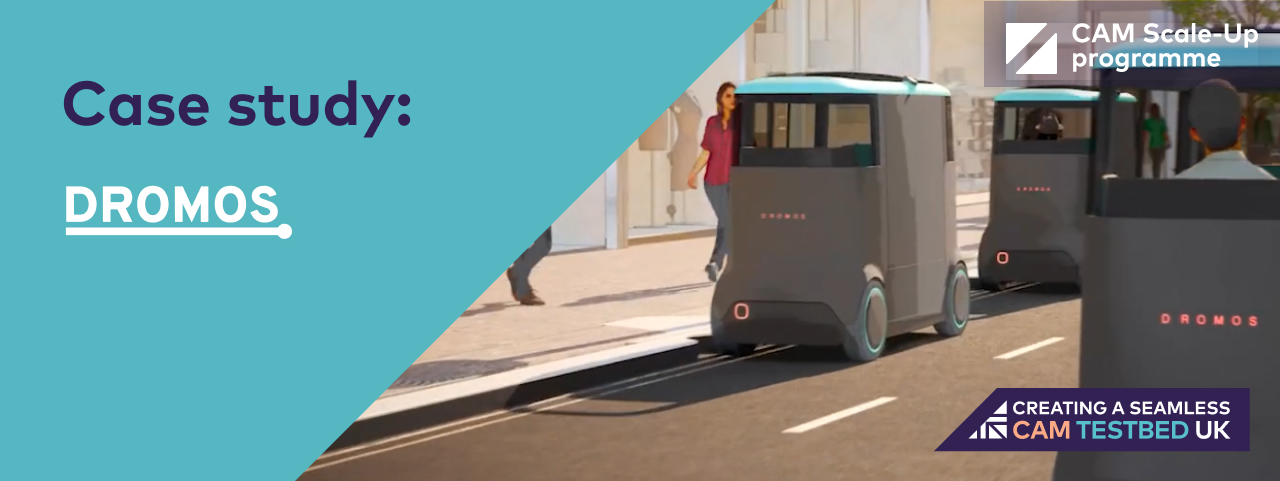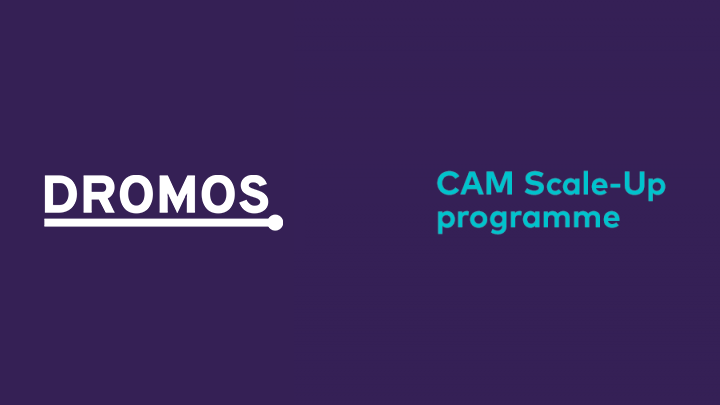



Dromos and the Zenzic CAM Scale-Up programme
An Autonomous Network Transit solution that revolutionises high volume mobility

Dromos has developed a high-volume public transport system with its own dedicated infrastructure that designed to transform high-density urban transportation. It’s a service that is highly convenient for passengers and both cost- and space-efficient for cities.
Dromos is focused on developing the next level of urban mobility. It was founded by Dr. Antje Völker and Dr. Martin Dürr who each have over 25 years of experience in the transportation industry. They were familiar with the pressures and limitations around transportation in an urban environment, and in particular they wanted to devise a solution that reduced traffic congestion and overcrowding from passengers of buses and subways. They were also aware that one of the key drawbacks for cities is the cost of transportation systems, which tend to run into the billions annually. Dromos reduces the need for this by developing a solution that provides high performance public transport without the need for subsidies.
Antje Völker explains:
We’ve seen great strides made in industrial supply chains. They’ve been optimised with new technology and digitalisation. However, these innovations haven’t extended to public transportation, in fact, we’re still using the same technology that was invented in the 19th Century. Dromos seeks to change that. We want to create a transport system that’s convenient, reliable and avoids overcrowding.”
What makes Dromos special?
They operate on dedicated infrastructure, similar to high-capacity bike lanes. The Dromos vehicles are small-scale and electric with a dual purpose; to transport passengers, and to be used as freight vehicles. The design of the car also has some key benefits, namely that it’s private; seating up to 4 people per car, it’s on demand and it’s highly accessible. As for the infrastructure, it will have a positive impact on the surrounding environment because it’s climate neutral, silent, and congestion free.
Beyond the infrastructure, Dromos have developed a Traffic Flow Management system using artificial intelligence algorithms that enable them to implement a level of customer service that is unparalleled, for a fraction of the cost. It allocates vehicles by forecasting the demand at, and between specific stations. This takes into account peak traffic times, weather and location-specific traffic flows, such as events in the area. From there, Dromos can allocate vehicles in advance to ensure wait times are nearly nonexistent. The Dromos team estimates that their solution is so efficient it will be able to transport approximately 20,000 people per hour, which is equivalent to a subway system.
Dromos doesn’t just provide incredible efficiency for end-users, it also offers a real business advantage. The costs to build Dromos’ solution is 50% less than legacy systems and it reduces at least half of carbon emissionsduring operations. It’s also quick to implement. The Dromos team projects that their technology can be up and running in a third of the time of alternative solutions.
Dromos’ testing journey
Utilising facilities across CAM Testbed UK to stress test the capabilities of their transit solution

Dromos tested their solution at UTAC Millbrook-Culham and Smart Mobility Living Labs: London. The first phase of testing focused on synchronising vehicle movements in intense flows at the UTAC proving grounds, which offered dedicated and safe spaces to rigour test their technology. They then tested their boarding processes, with the aim to implement a seamless integration between vehicles and passengers at a boarding station, trying out various layouts to discover the optimal outcome. Finally they took their solution to SMLL’s facility in London to test in an urban environment. This enabled them to simulate real-world scenarios for a more robust final outcome.
Martin Dürr shares: “The testing environment available as part of Zenzic’s CAM Scale-Up programme is world class. It gave us access to space where we can run our vehicles and the ability to source a crowd for services testing, which given the size of our current organisation would be impossible for us to achieve on our own.”
What would success look like?
Looking forward, in the next couple of years Dromos would like to see their first operating system up and running in either the UK or Germany. Beyond that, they envision Dromos implemented globally, both in cities that currently have a sophisticated metropolitan infrastructure as well as in developing areas that could benefit from Dromos’ more financially accessible mobility solution.
Programme results
Dromos’ testing programme has resulted in business success across three core aspects.Efficiency
Dromos demonstrated efficient vehicle and passenger movements when approaching and departing boarding zones.
Simulation
They were able to provide a simulation on the improvement of London’s city landscape and livability utilising Dromos’ vision for next-generation mobility.
Analysis
Dromos identified potential applications in Central London, analysed their feasibility, their impact on mobility behaviour, and their sustainability footprint.
More SME case studies

Connected Collision Management Platform empowering Automotive organisations to deliver transformational customer and claims experiences

Calyo is developing the next-generation AI-enabled perception system that offers an unprecedented combination of high performance, flexibility and low cost for smart mobile robots and autonomous vehicles.

Eloy is a connected and autonomous vehicle software business focused on multi-vehicle coordination. Our software includes patent pending methods for orchestrating how human-driven and autonomous vehicles travel.

Leading the way in road scape and highways information.

Breakthrough Radar Vision for Autonomy

PolyChord is a spinout from Cambridge University Astrophysics with uniquely powerful data science technology.
Find out more about the
CAM Scale-Up programme
discover more

Talk to us
Want to talk about connected and automated mobility in the UK and see how Zenzic can help you?
{{ teamMember.name }}
{{ teamMember.title }}
